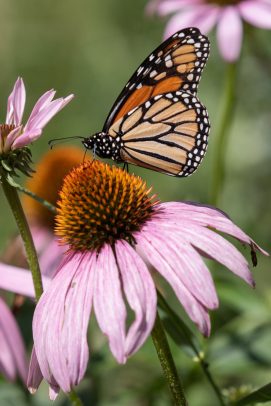UIC-led effort to protect the monarch butterfly surpasses 50 industry partners
The population of eastern monarch butterflies overwintering in Mexico has fallen dramatically in the last three decades, and this year marked the second-lowest number ever.
However, a far-reaching partnership led by UIC to protect this vital pollinator has just gotten a boost, surpassing more than 50 companies and government agencies that have joined the partnership to create and manage monarch butterfly habitats.
With falling monarch populations, voluntary conservation efforts have become increasingly essential to address habitat loss and threats to monarchs and other insect pollinator species.
The partnership, the Nationwide Candidate Conservation Agreement with Assurances for the Monarch Butterfly on Energy and Transportation Lands, or Monarch CCAA, is a first-of-its-kind endeavor to protect the monarch butterfly. To date, 30 energy companies, 14 state departments of transportation and seven counties across the U.S. have voluntarily committed to create and manage habitats for the monarch butterfly on energy and transportation lands.
The University of Illinois Chicago’s Energy Resources Center, which administers the Monarch CCAA, announced that the partnership had surpassed 50 members on March 6 during the Monarchs and More Network Meeting in Austin, Texas.
“The footprint of energy and transportation rights-of-way in the U.S. is roughly half the size of the National Park system, making these linear landscapes a valuable opportunity to create quality habitat and connect existing habitat fragments,” said Iris Caldwell, program director at UIC’s Energy Resources Center.
CCAAs are formal agreements between the U.S. Fish and Wildlife Service and non-federal property owners and land managers that encourage voluntary conservation to support at-risk species such as the monarch butterfly. Through the Monarch CCAA, energy and transportation organizations voluntarily adopt conservation measures to provide and enhance monarch butterfly habitat, including milkweed, the sole food source for monarch larvae.
With current partnership commitments, approximately 915,000 acres will be managed as monarch habitat across 41 states. Partners must monitor the habitat they create or manage under the agreement, which adds to the overall understanding of the availability of habitat resources on energy and transportation lands.
Since the Monarch CCAA was established in 2020, enrolled partners have collected habitat data from more than 6,980 plots. The aggregated data are reported to the U.S. Fish and Wildlife Service’s Monarch Conservation Database to inform upcoming listing decisions under the Endangered Species Act.
“This milestone is a great example of how public-private partnerships can be successful to conserve vulnerable species, like the monarch butterfly,” said Will Meeks, Midwest regional director of the U.S. Fish and Wildlife Service. “I want to thank each and every enrollee for driving this agreement forward to increase habitat that not only benefits monarchs, but an array of other wildlife and plant species.”
The Monarchs and More Network meeting, hosted by UIC’s Rights-of-Way as Habitat Working Group, the Monarch Joint Venture and Farmers for Monarchs networks, brings together more than 200 partners to support cross-sector collaboration efforts for pollinator conservation.
“We continue to be encouraged by the level of interest in the Monarch CCAA program. There is visible enthusiasm among our energy and transportation partners to help address the conservation needs of monarchs and other pollinators,” Caldwell said. “As we celebrate this enrollment milestone, we are excited about the future of the program as it grows in terms of number of partners engaged and habitat acres on the ground.”

